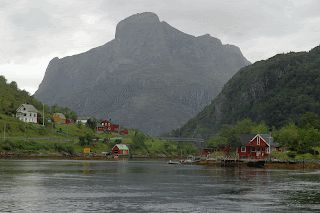Whilst in Norway I ran the boat aground. We had decided to visit the attractive
village of Hadbakke and from thestart the detail of the chart made it clear
that this would be a difficult entry.
However Swan has been in before and we had an on board pilot from one of
those visits. He advised the north
channel and as we approached I became concerned that it really did appear very
narrow but was reassured that breadth and depth are not correlated. Never the less I slowed down to under a knot
and just as we entered the pilot questioned his memory but we were committed. We grounded gently with an initial bump and
then a short grind. We immediately ran
in reverse but Swan wasn’t moving. There
are a number of other immediate actions such as checking hull integrity,
shifting weight aft and of deploying anchors and inflatable. All of which we initiated. A
feature of all propellers is a trait known as “prop walk” as well as driving
the boat ahead or astern a propeller produces a force that “walks” the stern
sideways its most pronounced at low speed and with her keel held somewhere
forward she was simply trying to turn.
Fortunately our plight was spotted by two local fishermen who passed a
line and by countering the prop walk allowed us to run off easily. We followed them in through the south channel
without further incident. We monitored
bilge water levels for the next 2 hrs and I am happy to say that there is no
evidence of any damage.
What to do next. Well
it was minor and some suggested that no further action was required. Instead though I reported myself to the
chairman of the ops committee. We have
had a very easy chat about the incident.
So what lessons? Well
I think there are two. One of my
expedition maxims was about contingency.
In this case it was the slow speed of approach. I might often appear over cautious when
entering harbour but just this one incident vindicates that caution. The second is that having had the accident do
the right thing not the easy thing.
We cleared the Norweigan coast in a lumpy sea. Having cleared the land I went below for a
sleep before coming up for watch on later in the small hours. I was told that one of the passengers had
been sick, not an entirely unexpected occurrence and apart from feeling sorry
for them thought no more on it. Later
that day I heard the full story. The
passenger had been below trying to put on waterproofs when she feel and knocked
herself out momentarily. She was then
helped on to a seat and sat for 15 minutes, the motion made her feel sick and
she then came up and was sick before going below and lying down. Understandably she didn’t stand a watch. Once I learnt about the entirety, I carried
out some basic checks but by now it was more than 12 hours after the
incident. All appeared normal and I kept
a close watch on her. She objected to the fuss but acknowledged some continuing
discomfort.
She was seen by a doctor on return to Shetland for
reassurance and I am happy to say that there was discomfort but nothing more
serious.
So despite my earlier post about having sorted out the
medical chest, the follow up to this incident did not go as it should have
done.
So what lessons?
These accidents do happen and therefore they can happen to you. There is clearly a technical learning in
first aid terms. Perhaps most
importantly it highlights how despite an extensive medical chest, medical
guides and first aid books, we humans can sometimes get it wrong. There is an adage “its not what you know or
have, its what you do with what you know or have.” We simply didn’t use our knowledge and tools
to best effect.
“Do it now ,not later” was another of my expedition
maxims. When the weather Gods
interfered with our planned departure for Orkney, we delayed by 36 hours. And even then had an uncomfortable and
lengthy crossing. That delay was
prudent and seamanlike even if it had
other unfortunate consequences about not meeting a planned timetable. Do it now not later doesn’t mean rush in, it
means once you have identified that the time is right to do something, get on
with it. I suppose “make hay whilst the
sun dose shine” or don’t put off the business of today until tomorrow might be a
better articulation.


























